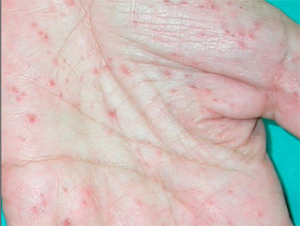What is Gorlin Syndrome?
How Gorlin syndrome is diagnosed
In general, Gorlin syndrome is diagnosed when a child or adult has at least two major criteria (symptoms or signs) of Gorlin syndrome and one minor, OR one major criterion and at least three minor criteria.

Small pits on the palms of the hand and soles of the feet are one of the major criteria of Gorlin syndrome.
Major criteria (symptoms) of Gorlin syndrome:
- Two or more basal cell carcinomas (BCCs) that appear prior to age 30
- Jawbone cysts called keratocystic odontogenic tumors (KCOTS)
- Small dots or pits on the palms and soles
- Calcified falx cerebri or calcium deposits in the brain
- A family history of Gorlin syndrome
- Medulloblastoma, a malignant brain tumor in children
Minor criteria (symptoms) of Gorlin syndrome:
- Large head size and protruding forehead
- Cleft lip or palate, extra fingers or toes
- Abnormally shaped ribs or bones in the spine
- Eye problems such as cataracts, small eyes, or tumors in the iris
- Benign fibrous tumors in the ovaries or heart
- Abdominal cysts
- Calcified ovarian cysts
Genetic testing
As part of the diagnosis process, a provider may ask for a genetic test to be performed on the person suspected of having Gorlin syndrome. A genetic test is a type of medical test that searches for changes in genes, chromosomes or proteins in the body to diagnose a genetic disorder or help determine the likelihood of someone developing or passing on a genetic disease.
Typically, a medical geneticist or dermatologist will perform a series of exams to determine how Gorlin syndrome is affecting the patient’s body. These include:
- An exam of the patient’s skin for basal cell carcinomas, pitting on hands and feet, areas of skin discoloration, and small cysts (milia) around the eyes and nose and elsewhere
- An exam of the face and head to identify any abnormalities of the face, skull, teeth and jaws
- An exam of the body to identify any issues with the rib cage, sternum, spine and shoulders
The health care provider may also order non-ionizing radon tests or MRI imaging of the patient’s head and body to identify any calcification in the brain, jawbone cysts/KCOTs, and bone abnormalities.
Additionally, the person may be screened for non-cancerous fibromas in the heart or ovaries as part of the evaluation for Gorlin syndrome.
What to bring to your first appointment

If you suspect you or your loved one may have Gorlin syndrome, make an appointment with your health care provider.
To help your health care provider better understand your medical situation, bring the following information to your first appointment.
A detailed health history that captures:
- Any skin problems
- Any birth defects such as large head size, hydrocephalus, undescended testicles, or a hernia, cleft palate
- Height/weight through childhood as compared to siblings
- Any malignant childhood brain tumors
- Any heart or fertility issues
- Excessive exposure to the sun, farm chemicals and radiation
- History of family members who may also have Gorlin syndrome
Learn more about building a care team to manage Gorlin syndrome.
